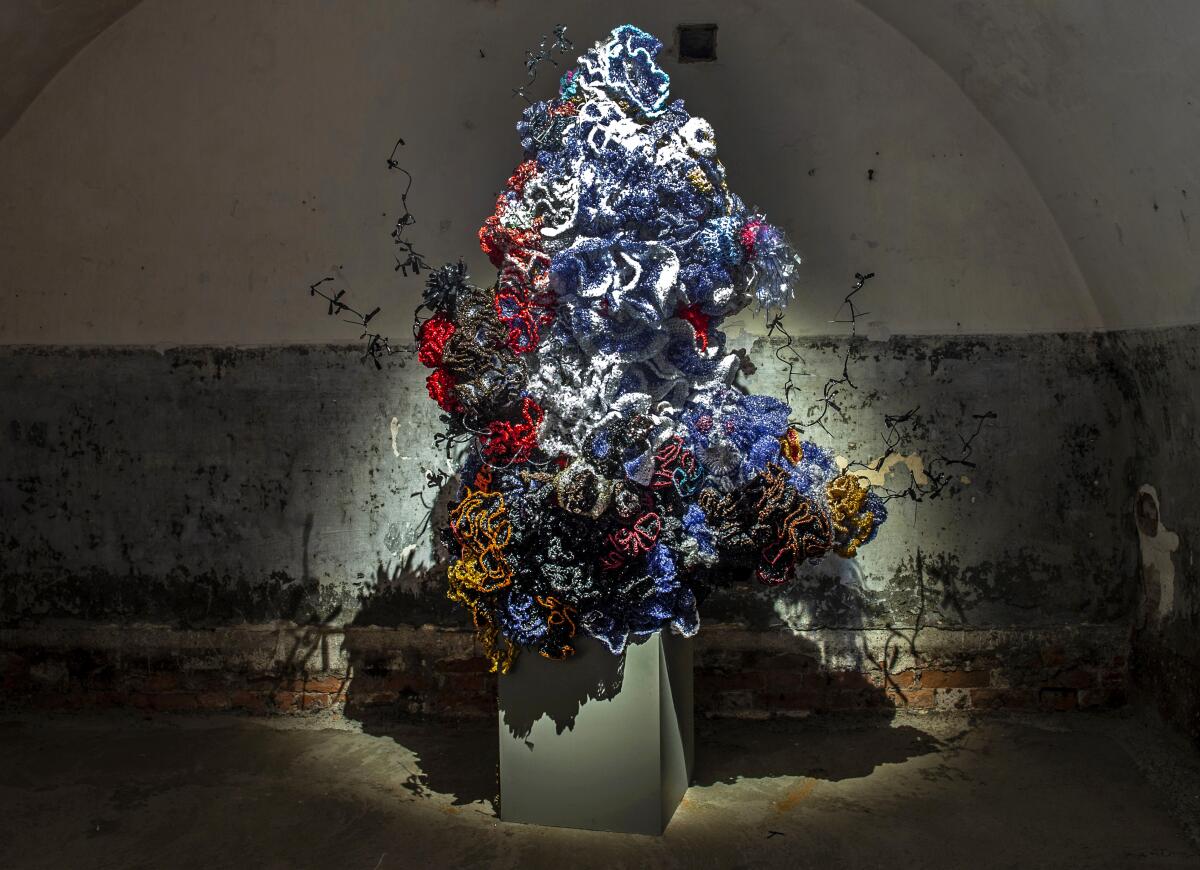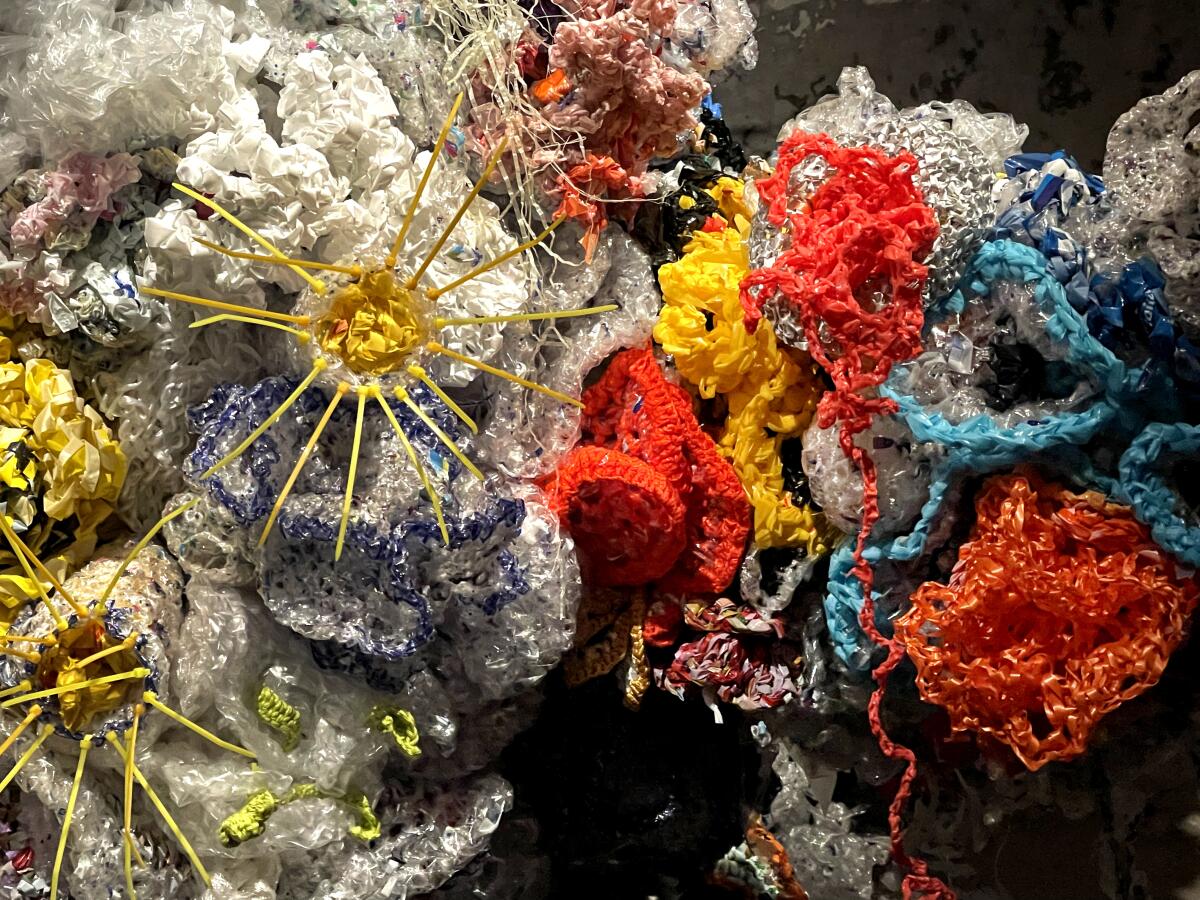Op-Ed: Art imitates life — not even a plastic crocheted coral artwork can stand up to climate change

While world leaders dither about how to tackle climate change, an eerie echo of global warming’s destructive power has been playing out in a project created as an artistic response to this apocalypse. Even art can be destroyed by the toxic effects of our runaway carbon emissions. Even plastic art.
In 2005, around the time scientists were recognizing that abnormal patterns of coral bleaching were related to rising ocean temperatures, my sister and I started to crochet simulations of living reefs. It was art meets science meets environmental catastrophe channeled through the medium of a handicraft we’d grown up with. Crochet wasn’t an arbitrary choice, for the frilly, crenelated forms of real coral organisms are biological manifestations of hyperbolic geometry — a mathematical structure easily emulated with crochet.
To our surprise, our “Crochet Coral Reef” has blossomed into a community art project spread across the planet, with now nearly 20,000 crocheting participants in 50 cities and countries, almost all of them women. We have worked with crafters to create crochet reefs in London, New York, Chicago, Melbourne, Abu Dhabi, Latvia and many other places. Woolly reefs are currently underway in Germany and Canada, and in New York state and North Carolina. But it was in Finland where the forces of destruction recently played out.
Nonfungible tokens are a dressed-up species of bookkeeping. But what art needs is less auditing and more ecstasy.
As part of the Helsinki Biennial this year we were invited to work with citizens there, and an astonishing 3,000 Finns took part. During COVID-19 lockdowns many people everywhere turned to crafts as a calmative force, and crocheting corals also offers a purposeful rejoinder to environmental devastation. Just as living reefs are made by millions or billions of tiny coral polyps, so our reefs are generated by thousands of crocheters working together. Both biological and crafty reefs exemplify the power of collaboration at scale. The Great Barrier Reef, which served as the inspiration for our project, is the largest living thing on Earth, and one of a few organisms visible from outer space.

In addition to crocheting in yarn, we asked the Finns to use plastic. My sister and I have been crocheting plastic into corals since we learned about the horror of the Great Pacific Garbage Patch in 2006. How ironic that as living reefs disappear, giant whorls of plastic trash are forming in the ocean, as if a kind of synthetic replacement were going on.
It’s hard now to buy anything not packaged in plastic. Remember those pandemic months when we stockpiled toilet paper, each jumbo pack swaddled in a see-though plastic membrane? This emblem of viral infection became a feature of the Helsinki project when local reef organizer Lotta Kjellberg approached a manufacturer of toilet packaging about possible crafty byproducts.
As toilet paper packaging film rolls off the production line, an inch-wide strip is cut from the edge, making a perfect medium for crochet. Two hundred kilos of the stuff was delivered in a dumpster to Kjellberg’s door. In a time-consuming act of devotional recycling, she distributed it around Helsinki to libraries, craft stores, community centers, schools and senior citizens’ facilities. Tinted an elegant blueish-violet and dotted with pale splashes of ink, its availability in such quantity enabled the creation of a huge number of color-coordinated plastic corals. We could not have wished for a better scenario.
Two Steps is a perfect snorkeling spot on the Big Island of Hawaii.
In my first foray out of Highland Park in 15 months, I flew to Helsinki in May to work with a team of local ladies to shape thousands of individual crocheted pieces into large-scale sculptures. Along with the violet and whites of the loo-paper packaging were sparkling black videotape corals, plus others in reds, yellows and blues made out of gift-wrapping ties, grocery bags and various synthetic detritus. All of it recycled material.
The four resulting artworks were magnificent testimonies to community-centered art. Gorgeous, absurd, lavish forms bursting with life — together they formed a faux ecology that rehabilitated rubbish through female craft.
But over the summer, Finland experienced one of the hottest, wettest periods in its recorded history. Farther north, the Greenland ice sheet was also drenched in rain, an unheard-of phenomenon — it never rains in Greenland — and an ominous sign of the forces being unleashed in our atmosphere.
At the Biennial, most of the artworks were displayed on an island off Helsinki in a series of stunning abandoned fortifications. Unfortunately, the rooms became infested with mold. Other artists’ projectors burned out, sound systems fritzed, video screens dripped with slime. But these were solvable problems. For the corals a more permanent tragedy ensued.
Blobs of mold blossomed on the pedestals and understructures of the works. Possibly it had creeped into the crochet stitches too. Now, instead of traveling on to other exhibitions, these beautiful monsters have had to be destroyed.
Art has imitated life. Even crocheted plastic sea creatures can’t withstand the consequences of humanity’s petrochemical ensorcellment. Killed off by climate change, this unique colony of Helsinki corals has disappeared, echoing the fate of its living cousins who also soon may be mere memories.
Margaret Wertheim is a science writer and artist. The “Crochet Coral Reef,” created with Christine Wertheim, has been exhibited at the 2019 Venice Biennale and many other international venues. crochetcoralreef.org
More to Read
A cure for the common opinion
Get thought-provoking perspectives with our weekly newsletter.
You may occasionally receive promotional content from the Los Angeles Times.










